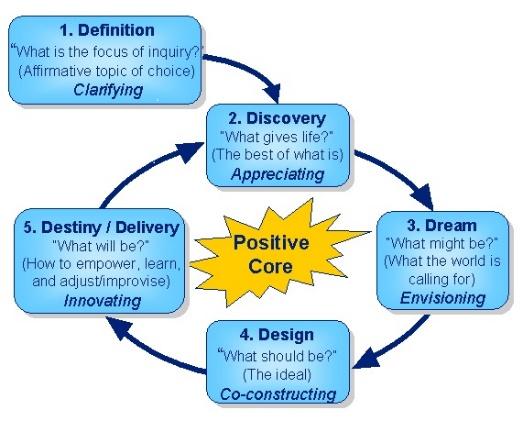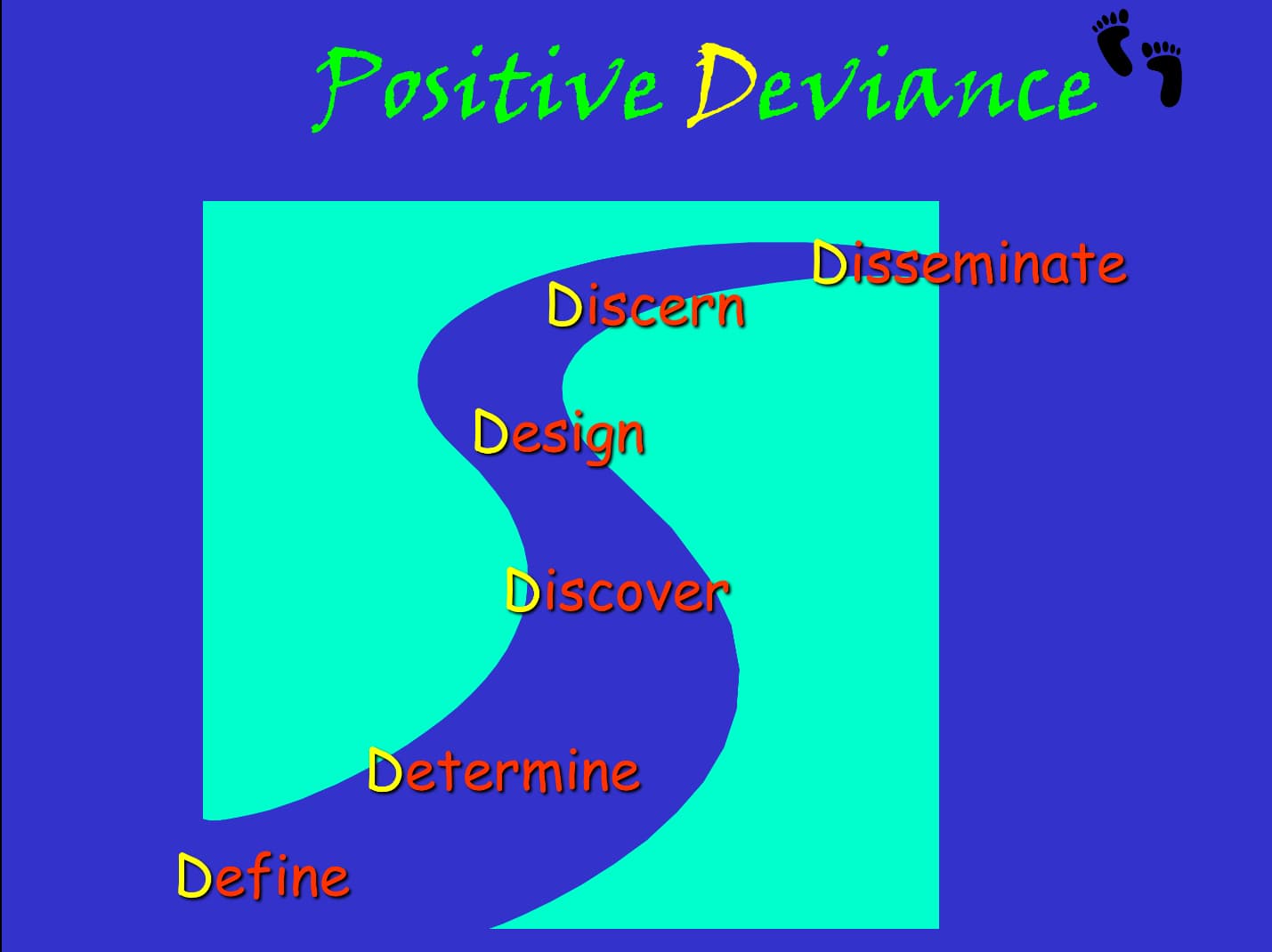KM Component 26 – Appreciative Inquiry and Positive Deviance

Stan Garfield
Appreciative Inquiry and Positive Deviance are two methods for identifying what works well and what could be and allowing organizations to take advantage of these findings. Both methods take a positive approach to change, instead of focusing on problems to solve or obstacles to overcome.
Appreciative Inquiry is abbreviated as AI, and is not be confused with Artificial Intelligence, also abbreviated as AI.
Appreciative Inquiry
Appreciative Inquiry (AI) involves asking questions that strengthen a system’s capacity to apprehend, anticipate, and heighten positive potential. It is the mobilization of inquiry through the crafting of the unconditional positive question.
AI is the co-evolutionary search for the best in people, their organizations, and the relevant world around them. In its broadest focus, it involves systematic discovery of what gives life to a living system when it is most alive, most effective, and most constructively capable in economic, ecological, and human terms.
As a method of change, Appreciative Inquiry differs from traditional problem-solving approaches. The basic assumption of problem-solving is that people and organizations are fundamentally broken and need to be fixed. The process usually involves identifying key problems, analyzing the root cause of failure, searching for possible solutions, and developing an action plan.
In contrast, the underlying assumption of Appreciative Inquiry is that people and organizations are evolving and growing. Appreciative Inquiry focuses the whole organization on identifying its positive core – its greatest assets, capacities, capabilities, resources, and strengths – to create new possibilities for change, action, and innovation. The steps include discovering the organization’s root causes of success, envisioning bold new possibilities for the future, designing the organization for excellence through dialogue, and co-creating the future.
Use Appreciative Inquiry to help make the corporate culture more positive, get the best out of collaboration and communities, and to evolve from problem solving to innovation. This process can be applied in almost any context, and the philosophy can be applied in communities, training, communications, user assistance, rewards, lessons learned, proven practices, collaboration, and management of change.
5-D Cycle of Appreciative Inquiry
- Define – What is the topic of inquiry? – It is important to define the overall focus of the inquiry (what the system wants more of). Definition is used to clarify the area of work to be considered. In spite of being the starting point of the cycle, it’s a recent addition – the 5Ds were originally the 4Ds, including discover, dream, design and destiny. Definition defines the project’s purpose, content, and what needs to be achieved. In this phase, the guiding question is, “What generative topic do we want to focus on together?”
- Discover – Appreciating the best of ‘what is’ – Discovery is based on a dialogue, as a way of finding ‘what works’. It rediscovers and remembers the organization or community’s successes, strengths and periods of excellence.
- Dream – Imagining ‘what could be’ – Imagining uses past achievements and successes identified in the discovery phase to imagine new possibilities and envisage a preferred future. It allows people to identify their dreams for a community or organization; having discovered ‘what is best’. They have the chance to project it into their wishes, hopes and aspirations for the future
- Design – Determining ‘what should be’ – Design brings together the stories from discovery with the imagination and creativity from dream. We call it bringing the ‘best of what is’ together with ‘what might be’, to create ‘what should be – the ideal’.
- Deliver/Destiny – Creating ‘what will be’ – The fifth stage in the 5Ds process identifies how the design is delivered, and how it’s embedded into groups, communities and organizations. In early appreciative inquiry development, it was called ‘delivery’, based on more traditional organizational development practice. The term ‘destiny’ is more prevalent now.

AI was cofounded at Case Western Reserve University by David Cooperrider and the late Suresh Srivastva. According to Cooperrider, “In my view, the problem-solving paradigm, while once incredibly effective, is simply out of sync with the realities of today’s virtual worlds. Problem solving is painfully slow (always asking people to look backwards historically to yesterday’s causes); it rarely results in new vision (by definition we say something is a problem because we already implicitly assume some idea, so we are not searching to create new knowledge of better ideals, we are searching how to close gaps), and, in human terms, problem solving approaches are notorious for generating defensiveness (it is not my problem but yours).”
Positive Deviance
Positive Deviance (PD) is an approach to change. It is based on the observation that in any community, there are people whose uncommon but successful behaviors or strategies enable them to find better solutions to a problem than their peers, despite facing similar challenges and having no extra resources or knowledge.
PD is an asset-based, problem-solving, and community-driven approach. It enables a community to discover successful behaviors and strategies and develop a plan of action to promote their adoption by all concerned.
In the early 1990s in Vietnam, Jerry and Monique Sternin, working for Save the Children, experimented with Marian Zeitlin’s PD concept and operationalized it to eradicate childhood malnutrition in a sustainable way as mandated by the Vietnamese government. Thanks to the dedicated work of local organizations working together for the first time, the community-based and owned pilot project was successful in rehabilitating 93% of children and was subsequently scaled up to reach 5 million families in Vietnam.
The Six Ds of Positive Deviance Approach
- Define the problem, its perceived causes, related current practices (situation analysis), and what a successful solution or outcome would look like. Describe the desired outcomes as changes in behavior or status.
- Determine if there are any individuals or entities in community who already exhibit desired behavior or status. Identify the positive deviants.
- Discover uncommon practices or behaviors enabling the positive deviants to outperform or find better solutions to the problem than others in their community.
- Design and implement activities enabling others in the community to access and practice new behaviors. Focus on doing rather than transfer of knowledge.
- Discern the effectiveness of activities or project through ongoing monitoring and evaluation.
- Disseminate the successful process to appropriate others. This is scaling up.

Positive deviants can be found everywhere. Their special practices, strategies, and behaviors enable them to find better solutions to prevalent problems than their neighbors who have access to the same resources. Study what works and encourage replication by others.

Stan Garfield
Please enjoy Stan’s additional blog posts offering advice and insights drawn from many years as a KM practitioner. You may also want to download a copy of his book, Proven Practices for Implementing a Knowledge Management Program, from Lucidea Press. And learn about Lucidea’s Inmagic Presto and SydneyEnterprise with KM capabilities to support successful knowledge curation and sharing.
Similar Posts
Lucidea’s Lens: Knowledge Management Thought Leaders Part 79 – David Garvin
KM expert David Garvin was a proponent of organizational learning to counter unpredictability in market forces and technology advances.
Lucidea’s Lens: Knowledge Management Thought Leaders Part 78 – Carl Frappaolo
KM expert Carl Frappaolo was the creator of Delphi’s Knowledge Management Methodology (KM2)
Lucidea’s Lens: Knowledge Management Thought Leaders Part 77 – Leif Edvinsson
Leif Edvinsson, Professor Emeritus at Lund University in Sweden, specializes in Intellectual Capital Management of Enterprises, Cities, and Nations
Lucidea’s Lens: Knowledge Management Thought Leaders Part 76 – Seth Earley
Seth Earley works in cognitive computing, knowledge engineering, data management systems, taxonomy, ontology, and metadata governance strategies.

Leave a Comment
Comments are reviewed and must adhere to our comments policy.
0 Comments